|
Shortly before his death in
Jerusalem at the age of 89, archeologist Sir
Flinders Petrie (knighted by King George V in
1923) willed his head (thus his brain) to the Royal
College of Surgeons in London. He believed
that a study of the shape and size of his skull and
an examination of his brain would be fruitful for
the study of genius. |
|
|
|
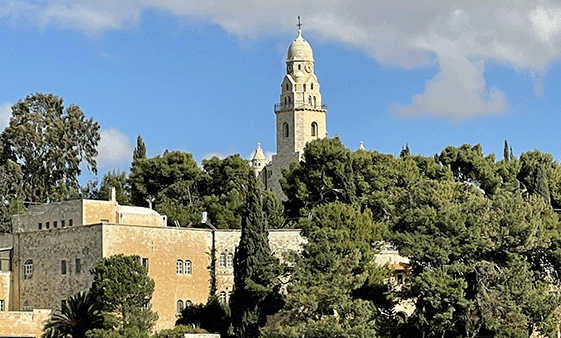 |
|
Photo: Gila
Yudkin |
|
Mount Zion where the headless body
of archeologist Sir Flinders Petrie
was buried in the Protestant Cemetery in 1942 |
|
|
|
But he had the misfortune to die in 1942, at the
height of World War II, and his head disappeared
when the ship carrying it was sunk by a German
submarine en route to London. So I learned
during my guide course in 1977 on
a visit to the Protestant Cemetery on Mount Zion
where his body is buried. A bizarre fact
like eminent archeologist Flinders Petrie’s head
being lost at sea while his body was interred on
Mount Zion is never forgotten! |
|
|
|
But this was fake news which I only discovered in
2021 (yes, forty-four years had passed!) while
preparing for a visit to Egypt. Reading a
biography of Petrie in Wikipedia, I came upon a
footnote mentioning a 2012 memorial service held by
the Israel Antiquities Authority marking the 70th
anniversary of Flinders Petrie’s death. |
|
|
|
In an even more bizarre twist, it turned out that
Petrie’s head had indeed reached its destination in
a crate marked “antiquities.” But the label on
the head preserved in a jar had fallen off.
Nearly five decades later, Shimon Gibson, an Israeli
archeologist working in London at the Palestine
Exploration Fund was contacted by the Royal College
of Surgeons to help “identify a head preserved in a
jar. They weren’t sure it belonged to Petrie.” |
|
|
|
Gibson who spoke at the memorial service said that
he arrived at the laboratory armed with photographs
of Petrie. “A laboratory technician brought me
the head, took it out of the jar and put it on a
plate in front of me….. He opened Petrie’s eyes.
They were bright blue,” stated Gibson. |
|
Flinders Petrie, considered the first biblical
archeologist in Palestine, came to Palestine in 1890
at the invitation of the Palestine Exploration Fund.
He already had a sterling reputation as an
Egyptologist, working on various digs in Egypt for a
decade. He was asked to excavate a tel
presumed to be biblical Lachish. It wasn’t. He
then moved to a nearby more promising site, Tel el
Hesi, where he discovered ten layers of cities.
Petrie was the one to recognize
stratigraphy for the first time, because he saw the
tel had been cut by flash flooding, exposing its
strata. Although the idea that a tel consists
of ruined cities piled on top of each other is today
considered commonplace, it sounded like science
fiction in the late nineteenth century. |
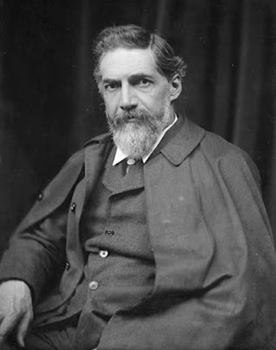 |
| |
| At Tel el Hesi Petrie
developed a method |
Courtesy of Wikipedia
Commons |
| for dating the layers
of a site according to |
Flinders Petrie in 1903 |
| the pottery and
ceramics found in each |
|
| layer.
This became the cornerstone of the archeological
dating process. He came to recognize that just as
modern dish patterns change, so did the pottery
styles in the ancient world. |
| |
| After
that one season in Palestine, Petrie returned to
Egypt, his first love. Six years later in
1896, while digging in southern Egypt, at Thebes,
today known as Luxor, Petrie discovered the
Merneptah Stele or Israel Stele. In his
own eyes, this was his greatest achievement: the
discovery of a black granite slab, over ten feet
(three meters) tall, incised with hieroglyphic
characters with the first mention of “Israel”
outside of the Bible. |
| |
|
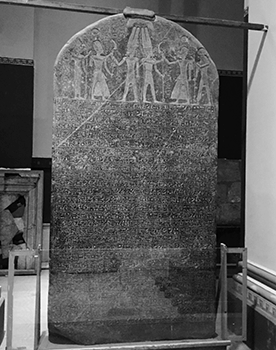 |
 |
|
Photo: Gila
Yudkin |
Courtesy of
Wikipedia Commons |
|
The Merneptah Stele in the |
Petrie's 1897 mirror
image copy of the |
|
Egyptian Museum in Cairo |
main part of the
inscription (all 28 lines) |
|
|
The
inscription says it was carved in the 5th year of
Merneptah of the 19th dynasty. Most of the text
glorifies Merneptah's victories over enemies from
Libya and their Sea People allies, but the final
three lines (out of twenty-eight) mention a campaign
in Canaan, where Merneptah says he destroyed the
cities of Ashkelon, Gezer, Yano’am and obliterated
Israel (in line 27).
|
| Here is
a translation of lines 26 to 28 according to
Wikipedia : |
| |
The
Canaan has been plundered into every sort of woe:
Ashkelon has been overcome;
Gezer has been captured;
Yano'am is made non-existent.
Israel is laid waste and his seed is not; |
| |
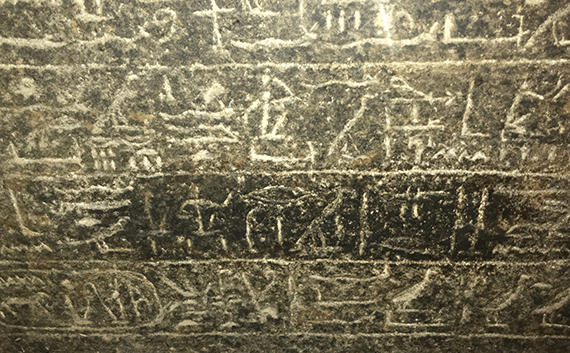 |
|
Photo: Gila
Yudkin November 2021 |
|
Hieroglyphic characters
interpreted as "Israel" are darker on the
second to the last line, as the stone has been
polished |
| |
| By the
time that the long-lived Ramesses II died, he had
outlived no fewer than twelve of his sons, and it
fell to his 13th son, Merneptah, to take the throne
of Egypt. In the fortieth year of Ramesses
II’s reign, Merneptah became the overseer of the
army. In Ramesses II’s 55th regnal year, when
celebrating his 80th birthday, Merneptah, at age 48,
officially become the heir to the throne. So
Merneptah would have had wide experience and
training by the time he ascended to the throne at
age seventy (plus/minus). |
| |
|
Merneptah ruled Egypt for about ten years, from 1213
BC to his death in May 1203 BC. Egypt had been
the dominant power in the region during the long
reign of Ramesses the Great. Problems began in
Merneptah's 5th year (1208 BC), when a Libyan king
invaded Egypt from the west in alliance with various
northern peoples. Merneptah achieved a great victory
in the summer of that year, and the inscription is
mainly about this. |
| |
| The
final lines deal with an apparently separate
campaign in the East, where it seems that some of
the Canaanite cities had revolted.
Traditionally the Egyptians had concerned themselves
only with cities, so the problem presented by Israel
must have been something new – possibly attacks on
Egypt's vassals in Canaan. Merneptah and his
successor Ramesses III fought off their enemies, but
it was the beginning of the end of Egypt's control
over Canaan. |
| |
| The
Merneptah Stele discovered by Petrie in 1896 is
considered to be the first extra-biblical reference
to ancient Israel and is widely considered to be
authentic and providing historical information. |
| |
|
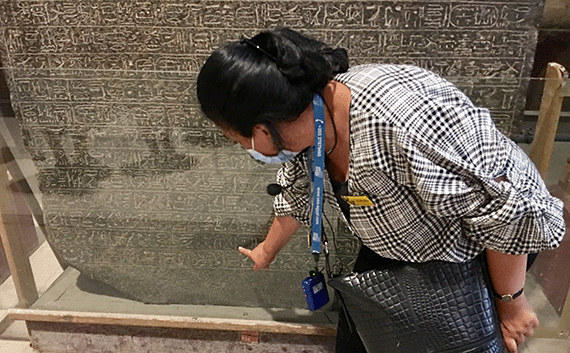 |
|
Photo: Gila
Yudkin November 2021 |
|
Egyptologist
guide pointing out "Israel" on the Merneptah Stele
in Cairo |
|
|
The stele itself was a recycled stone, engraved on
the rough back of the stele of an earlier pharaoh,
Amenhotep III, which was removed from his temple,
and placed with its back outward, against the wall,
in the forecourt of the temple of Merneptah.
|
As described by Petrie’s student and biographer
Margaret Drower, in early 1896, Petrie and his
archeological team were conducting excavations on a
temple in Petrie's area of concession at Luxor.
This temple complex was located just north of the
original funerary temple of Amenhotep III, which had
been built on a flood plain.
They were initially surprised that this building
which they were excavating was also attributed to
Amenhotep III since only his name appeared on blocks
strewn over the site. They wondered, could one
king have had two mortuary temples? |
|
|
|
 |
|
Photo: Gila
Yudkin November 2021 |
|
Colossal statues of Amenhotep III
found by his mortuary temple plundered by Merneptah
in the 13th century BC / This area is being
excavated in 2021 |
|
|
|
Petrie dug and soon solved the puzzle. The
temple had been built by Merneptah (an alternate
spelling used by the Egyptians is Merenptah), the
son and successor of Ramesses II, almost entirely
from stone which had been plundered from the temple
of Amenhotep III nearby. Statues of the latter
had been smashed and the pieces thrown into the
foundations; stone fragments of crouching jackals,
which must have once formed an imposing avenue
approaching the massive gateway, and broken drums
gave some idea of the splendor of the original
temple. |
|
|
|
A statue of Merneptah himself was found -- the first
known portrait of this king. When Petrie found the
black granite slab, over ten feet high and larger
than any stele previously known, lauding the
building achievements of Amenhotep III and turned it
over, he saw a very long inscription. Petrie
asked a noted German scholar working in the area to
read it. Near the end of the long text, the
German scholar was puzzled by one name, that of a
people or tribe whom Merneptah had victoriously
smitten. Hesitatingly, he suggested, “I.si.ri.ar?” |
|
|
|
According to biographer Drower, “It was Petrie whose
quick imaginative mind leapt to the solution:
"Israel!" His German colleague agreed that it
must be so. "Won't the reverends be pleased?"
was his comment. At dinner that evening Petrie
prophesied, "This stele will be better known in the
world than anything else I have found." He was
right on the mark! |
|
|
|
 |
|
Courtesy of
Wikipedia commons in the public domain |
|
Closeup of "Israel" in
hieroglyphics, line 27 on the Merneptah Stele |
|
|
|
Flinders Petrie was famed for his stamina, stoicism
and eccentricity. At one point T.E. Lawrence,
otherwise known as Lawrence of Arabia came to
Petrie’s excavation camp to learn the rudiments of
archeology. Afterwards Lawrence tweeted, “A
Petrie dig is a thing with a flavor of its own.
Tinned kidneys mingle with mummy corpses and amulets
float in the soup.” |
|
|
|
Petrie’s wife Hilda shared his outstanding traits
and foibles. According to Petrie’s biographer,
Hilda described her bedroom to a childhood friend,
“At the head of my bed are four great cartonnage
heads of mummy cases with staring faces; at the side
are collections of alabasters and many bones hard
by; at the foot of the bed are 80 skulls.” |
|
|
|
Petrie remained in Egypt for 36 years before
returning to Palestine in 1926 at the age of 70.
He continued to work in the field for another 12
years! In 1938, at Tel el Ajjul near Gaza he
conducted his last dig. To the astonishment of
his team of young assistants, he insisted on walking
to the top of the tel twice a day. |
|
|
|
When “retired” from field archeology (but still busy
editing his memoirs), Petrie decided to live out his
remaining years in Jerusalem. While in
hospital he expressed the wish that his head be
severed from his body and donated to the Royal
College of Surgeons in London for examination.
His headless body is buried in the Protestant
Cemetery on Mount Zion. |
|
|
|
Egyptologist Toby Wilkerson sums up Flinders
Petrie’s contribution to archeology, Under spartan
conditions, “through his careful observation,
meticulous excavation, detailed record-keeping and
prompt publication, Petrie had transformed the
practice of archeology from a mixture of dynamite,
earth clearance and treasure-hunting into a precise
science. He had also changed the role of the
archeologist, where once digging had been a
part-time diversion for gentleman scholars, it was
now a full-time profession for experts.” (From
Toby’s Wilkerson’s highly recommended, A World
Beneath the Sands) |
|
|
|
Postscript: Where are they now? |
|
|
|
The grave of Flinders Petrie is located in
the Protestant Cemetery adjacent to the Jerusalem
College of Holy Land Studies on Mount Zion. |
|
|
|
 |
|
Photo: Gila
Yudkin November 2021 |
|
The Protestant Cemetery on Mount
Zion is located on the right side of this photo |
|
|
|
 |
|
Photo: Gila
Yudkin February 2022 |
|
Tombstone of Flinders Petrie in
the Protestant Cemetery on Mount Zion |
|
|
|
The head of Flinders Petrie is allegedly
still at the London Royal College of Surgeons, but
not available for view |
|
 |
|
Courtesy of
Wikipedia Commons in the public domain |
|
Royal College of Surgeons
of England in London |
|
|
|
The Merneptah Stele, or Israel Stele
can be seen in the Egyptian Museum in Tahrir
Square Cairo. In 2017 the Egyptian
Department of Antiquities changed the name
of the renowned stele from the Israel Stele
to the Victory Stele, dropping the name
Israel. [If you are planning to visit
the Egyptian Museum on your own, email gila
(gila@itsgila.com)
for exact directions to the stele.] |
|
|
|
 |
|
Photo:
Gila Yudkin November 2021 |
|
The Egyptian Museum in
Tahrir Square Cairo |
|
|
|
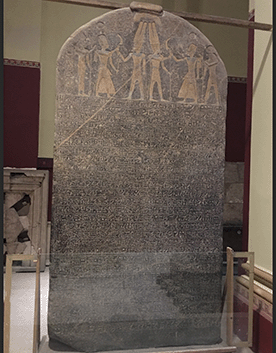 |
|
Photo:
Gila Yudkin |
|
The Merneptah Stele has
the first mention of "Israel" outside of the
Bible |
| |
| Merneptah
who was probably in his eighties when he
died in 1203 BC was originally buried in his
mortuary temple near his tomb KV8 in the
Valley of the Kings in Luxor. |
|
|
|
Merneptah's Tomb is located in the
Valley of the Kings in Luxor, southern
Egypt. |
|
|
|
 |
|
Photo:
Gila Yudkin November 2021 |
|
The couple is about to
enter Merneptah's Tomb in the Valley of the
Kings |
|
|
|
 |
|
Photo:
Gila Yudkin November 2021 |
|
Entrance to Pharaoh
Merneptah's Tomb, KV8 in the Valley of the
Kings |
| |
|
Merneptah's Mummy was located in 1898
along with eighteen other mummies (including
Queen Pharaoh Hatshepsut’s) in the mummy
cache found in the tomb of Amenhotep II near
the Valley of the Queens. Pharaoh
Merneptah's mummy was taken to Cairo and
eventually unwrapped and examined. |
| |
|
Merneptah’s body was 5 feet
6 inches tall (1.71 meters) and he
apparently suffered from arthritis. He
was almost completely bald. In April
2021 during the event dubbed the Pharaoh’s
Golden Parade presided over by the President
of Egypt, Merneptah’s mummy was moved from
the Egyptian Museum to the Royal Hall of
Mummies in the National Museum of Egyptian
Civilization due to open when the pandemic
ends. |
| |
|
Copyright 2021
Gila Yudkin. Permission needed for any reuse. |
| |
|
COMING TO
JERUSALEM?
BOOK GILA for a customized private tour |
| |
|
Gila
Yudkin, who celebrated four
decades of guiding holy land pilgrims before
the pandemic, tells her groups, “90% of what
I learned about archeology in my guide
course, 1977 to 1979, has been proven to be
false. Knowledge changes!” Gila
is constantly updating herself on the latest
theories, conjectures and finds. Even
more so during the pandemic when she is “on
the bench” waiting to reenter the
stimulating arena of guiding the holy land. |
| |
| |
| More Holy Land
explorers and headliners |
|
|

